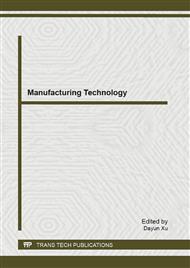p.283
p.291
p.297
p.302
p.308
p.315
p.321
p.325
p.331
Quality Monitoring of Surface Roughness and Roundness Using Hidden Markov Model
Abstract:
The surface roughness and roundness(SRR) are widely used indexes of mechanical product quality. How to implement the SRR monitoring is a crucial task. In this study, the hidden Markov models (HMMs) and the cutting vibration signals are applied to monitor the SRR in variant cutting conditions. Unlike most of the prior work only to reveal one element of the geometric specifications, based on the theoretical analysis of the influence of tool vibration displacement on the SRR, the vibration energy characteristic(VEC) is determined to serve as the characteristic for monitoring surface roughness(Ra) and roundness(Rd) synchronously.Which make up the insufficiency of the comprehensive monitoring of workpiece quality. Moreover, although classical hidden Markov models (HMMs) have been successfully used for fault diagnostics of mechanical systems, this method based on recognition rate is becoming unreliable to monitor the accuracy of the workpiece. Hence, the HMM-based judgment matrix method is proposed and it is tested and validated successfully using for SRR monitoring through a series of experiments.
Info:
Periodical:
Pages:
308-314
Citation:
Online since:
December 2012
Authors:
Price:
Сopyright:
© 2013 Trans Tech Publications Ltd. All Rights Reserved
Share:
Citation:


